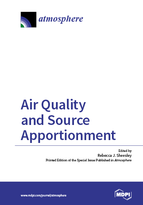Air Quality and Source Apportionment
A special issue of Atmosphere (ISSN 2073-4433). This special issue belongs to the section "Air Quality".
Deadline for manuscript submissions: closed (29 February 2016) | Viewed by 58394
Special Issue Editor
Interests: atmospheric particulate matter; organic aerosol; mega-cities; arctic aerosol; black carbon; molecular tracers; isotopes; anthropogenic aerosol; biogenic aerosol
Special Issue Information
Dear Colleagues,
Atmospheric particulate matter (PM) is known to have far-ranging impacts, from human health to climate forcing. The characterization of emission sources and the quantification of specific source impacts to PM concentrations significantly enhance our understanding of and our ability to eventually predict the fate and transport of atmospheric PM and its associated impacts on humans and the environment. The source apportionment of PM has been realized through combinations of chemical analysis (of elemental tracers, particle size, isotopic composition, and organic composition via unique tracers and molecular fingerprints) and numerical modeling (e.g., diagnostic source ratios, chemical mass balance modeling, positive matrix factorization, and Monte Carlo simulations).
Recent advances in source apportionment applications have contributed unique combinations of chemical and numerical techniques for determining the contributions of specific sources, including diesel exhaust and biomass burning. These advances also identify and help characterize the contributions of previously uncharacterized sources. Numerical modeling has also enabled estimations of contributions of emission sources to atmospherically processed PM in urban and rural regions.
Manuscripts for this Special Issue on source apportionment will be accepted if they relate to advances in chemical characterization, numerical modeling, and applications in uncharacterized regions. Regions in need of additional studies include South and East Asia, the Polar regions, and the interface of urban and agricultural areas.
Dr. Rebecca J. Sheesley
Guest Editor
Manuscript Submission Information
Manuscripts should be submitted online at www.mdpi.com by registering and logging in to this website. Once you are registered, click here to go to the submission form. Manuscripts can be submitted until the deadline. All submissions that pass pre-check are peer-reviewed. Accepted papers will be published continuously in the journal (as soon as accepted) and will be listed together on the special issue website. Research articles, review articles as well as short communications are invited. For planned papers, a title and short abstract (about 100 words) can be sent to the Editorial Office for announcement on this website.
Submitted manuscripts should not have been published previously, nor be under consideration for publication elsewhere (except conference proceedings papers). All manuscripts are thoroughly refereed through a single-blind peer-review process. A guide for authors and other relevant information for submission of manuscripts is available on the Instructions for Authors page. Atmosphere is an international peer-reviewed open access monthly journal published by MDPI.
Please visit the Instructions for Authors page before submitting a manuscript. The Article Processing Charge (APC) for publication in this open access journal is 2400 CHF (Swiss Francs). Submitted papers should be well formatted and use good English. Authors may use MDPI's English editing service prior to publication or during author revisions.






